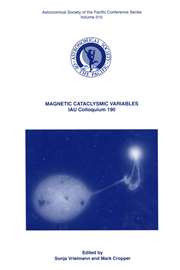Article contents
Fourier Analysis of Line-Profile Variations: Toward Stellar m – v Diagrams?
Published online by Cambridge University Press: 15 February 2018
Abstract
Numerous rapidly rotating δ Scuti stars exhibit variable line profiles containing traveling subfeatures [l]-[2], which may be signatures of nonradial pulsations having relatively high azimuthal order |m| We describe a procedure whereby a time series of spectral line profiles is Fourier analysed both in time and in a wavelength variable that is presumed to correspond to azimuthal position Φ on the star. What such an analysis can tell us is examined by analysing artificially-generated data. For an ideal example in which sin i = 1 and a single mode having  is present, the two-dimensional Fourier transform yields a power spectrum in frequency
is present, the two-dimensional Fourier transform yields a power spectrum in frequency  and an apparent azimuthal order
and an apparent azimuthal order  that provides a good indication of the actual
that provides a good indication of the actual  and m. Such a straightforward interpretation is also possible when sin i < 1, and when multiple sectoral modes
and m. Such a straightforward interpretation is also possible when sin i < 1, and when multiple sectoral modes  are present. For tesseral modes
are present. For tesseral modes 
 may correspond more closely to
may correspond more closely to  than to m.
than to m.
Information
- Type
- Stellar Seismology
- Information
- Copyright
- Copyright © Cambridge University Press 1993
References
- 1
- Cited by

